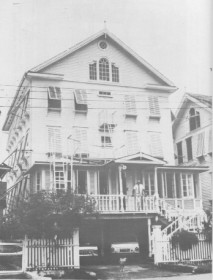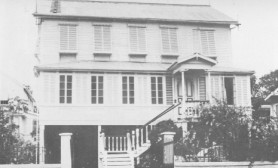This Rory Westmas article at least affords us a refreshing reflection on a time that was.
By Rory Westmaas
“Now that we are becoming conscious of ourselves as a nation, reaching out in new directions, thrusting into the interior, environments different from that of the familiar coast will present new problems. The better bearing strengths of those soils will permit us to build tall buildings and cities as large as those in any other country of the world—should we need them and want it so.”

There is a distinctive architecture of Guyana. It is to be seen in the many examples of timber domestic buildings for the most part in and around Georgetown. It is an architecture which has been derived from the many European States which at one time or another controlled the country. Ignoring the traditions of both the Amerindian and African slaves the settlers built in the styles existing at the time in their respective homelands; the resulting buildings nevertheless show the modifications in design and ornament dictated by the new climatic and environmental conditions as well as by the skills of the builders and their interpretations of the new ideas. Up to about forty years ago anyone asking a carpenter-contractor to erect a house would be given a building fashioned in the style now seen in the traditional house. This was done in many cases without a line being drawn on paper. Our domestic house building had long ago arrived at an accepted style. Many of these anonymous craftsmen builders had completely mastered the art of achieving composition in scale, massing and harmony and created buildings which were completely functional for their time and which are, even today, undeniably pleasing to the eye.
Argument on this point springs principally from our close familiarity with our building environment preventing us from seeing and respecting what we have accepted as commonplace. Secondly, the belief exists that the comparative impermanence of timber places it outside the meaning of the word Architecture —with a capital ‘A’. Yet, no one would deny the use of the word Art to describe fine examples of say African wood carving. The real reason for argument at all would appear to be a refusal to accept the past. The danger of this attitude is that it usually engenders a refusal to accept responsibility for the present and for the future.
Origin of ideas

If we are to understand anything about our architectural situation, about our building environment we should try to trace the origins of the many ideas infused into the country. We should try to see how these ideas have come down to us, how they have become part of our expression and ultimately if they are capable of being developed. For such an exercise the history books can give us little help. Europe colonised with doubtful human material; one island for example was ‘a dunghill whereon England doth cast forth its rubbish’. In any case in the early days there was a confused taking and retaking of territory with slaves, merchants, and privateers seeking pelf, power and patronage. Force was the judged between man and man, and if one was not the hammer then certainly he was the anvil. It was a time for action with only the ruins of men’s avarice, hopes and dreams to chronicle the deeds.
The written record can provide some of the basic facts but the body of truth lies in the graves and in the tombs of those who lived and died under our sun. But the truth also lies in the foundations, in the buildings, in the things those people made and in our names, place-names and language. With these clues and basic facts we must try to understand our past and our progress.
Spanish influence negligible
From the year 1498 when first Columbus sighted the coast of Guyana, Spanish and Portuguese fortune hunters began the search for El Dorado and Lake Parima believed to have shores of golden sand. These expeditions appeared to do nothing but guarantee the hostility of the Indians. There is mention of Spanish or Portuguese raids early in the 17th century and of the arrival of Portuguese Jews from Brazil colonising an area in the Pomeroon round about 1660, but certainly, at the beginning of the 17th century Guyana appears to have been free from the Portuguese or Spanish.
The architecture of Spain had already moved into the renaissance style by the middle of the sixteenth century and when the colonies were ceded to the Dutch in 1669 the style in Spain had begun to ‘decline’ into a Baroque. It is highly improbable that much in the way of architectural ideas has come down to us from the Spanish. Certainly there were Spanish attacks on other settlements but there is mention of little else.
Possibility of Portuguese influence
What little early activity there was on the part of the Portuguese appears to have left us nothing. The word verandah is given as Portuguese. If the idea for the verandah—one of the most delightlful features of the early traditional house—is theirs it would have come from a time after their arrival as agricultural labourers in 1840 and after they had amassed enough wealth to become the owners of ‘the best houses in every village’.
The possibility exists that they were the source of the richness of detailing which the traditional house carries—the fretwork panels over the entrance doors, gallery window-heads, the spandrels in the angles of timber ‘arches’ to the drawing room and on porches. The Moors it must be remembered had dominated the Iberian peninsula for 800 years which ended with their expulsion only in 1492. In these years the skill of the Moor craftsmen had established itself in the architecture of both Spain and Portugal. The Muslim religion did not accept natural forms in ornament— geometrical patterns in pierced stonework and intricate surface decoration were the order of the day.
.
Mixed influences on development of verandah
While some verandahs still show this decoration others reflect the more formal, clean lines of Georgian influence.
With the enclosure of the verandah mentioned later the decorative spandrel brackets sometimes used at the external column heads had to go only to re-appear on the porch.
It is difficult to ascribe the verandah to any one people; the name may have caught on but the element itself must have existed before the Portuguese arrived from Madeira. The decorative spandrels on the other hand, as mentioned later, can be seen as an interpretation in timber of a cast-iron detail—a little bit of Victorian exuberance.
Effects of slavery on house planning
In the beginning the condition of slavery in the New World meant living in cheap quickly constructed “cabaans”, cells, huts or ranges which were little more than shelters, more or less congested, as density increased or decreased. These were constructed on mud sills which were notched to receive wall studs. The walls would have consisted of “wattle and daub” or were lathed to take wallaba shingles. The floor would be of packed and polished mud or of timber. The range, depending on its size, would have a simple double-pitched roof of coupled rafters, couple-closed rafters or rafters with collars and would be covered with either palm leaves or shingle on lathes. Windows, either top hung or side hung, would be of the solid wooden shutter type. The hut or range in the first place would have no kitchen or area for food storage. Breakfast served in the field came from communal kitchens.
The law prohibited slaves owning their own huts and cheap and easy importation of more slaves as required did nothing to encourage marriage—both factors making an early mark on the planning of the Guyanese house. A people build with what they have. The first clearing of the coastlands provided an abundance of good timber—a material with which the slaves were well acquainted so that not only were the standardised plantation buildings constructed of timber, so were all buildings in the town as well. Bridges, vats, wharves, furniture, carts and even roads were built in timber.
The settlers interpreted their native styles in timber and the free black people in turn imitated them on a smaller scale.
Slaves and ships
The life of the colonies depended on two things: slaves and ships. Slaves to produce cotton, coffee and sugar; ships to transport them to Europe. The sailing ships in turn played a great part in bringing not only the much needed supplies for general use, they brought also in ballast, bricks and slates for the plantation ovens and for building, ice from the American lakes and later a variety of cast iron building components. This exchange of materials in the case of refractive bricks, for example, continues even today.
Certainly the settlers, probably the Dutch, must have organised brick manufacture here: the name Brickory attests to this fact but even with the abundance of good brick clay and with skilled slave and free brick-layers, timber proved more economical and building in. brick never really caught on. The many examples of brick culverts, sluice supports, and brick chimneys as at Chateau Margot attest to the skill of the craftsmen but it is more likely that the poor bearing capacity of the compressible coastal soils militated against heavier brick buildings.
Geography, the overriding influence
In 1668 Guyana and Suriname were ceded to the Dutch; for a short period in 1781 Guyana was held by the British to be captured and held by the French the next year until 1802 when it was restored to the Dutch who also held it for one year. In 1803 the British once more gained possession and remained in control until independence in 1966. However, over-riding all these influences were the ever-present hot, humid rain forest conditions on a coastland set below sea level. The impermeable clay soils, heavy rainfall and frequent floods demanded a floor raised above flood level. The floor had then to be suspended and approached by a short flight of steps.
The raised small house provided an area underneath for sheltering domestic animals. In the town:— first Longchamps from the French, renamed Stabroek by the Dutch, then Georgetown by the English—before the advent of good supply stores, the larger houses on pillars often had part of the ground floor enclosed to form a store room. This would also be the case in outlying districts where transportation was a difficulty. Later, after the abolition of slavery, the bottom house or ground floor areas were extended to provide accommodation for servants and family retainers.
The coastal Amerindians —the Warraus and Guaranos— at that time living in these swampy areas had already learned how to build their houses in trees. They cut trees to a height of five or six feet from the ground and built platforms on the tree trunks above the level of the flood waters.
Growth of domestic house
The abolition of slavery gave former slaves the chance to build and own houses and it is probably from this time that we can trace the growth of the domestic house in fairly simple stages by a process of adding on to a ‘body-house’. Before 1833 and even before 1574 the buildings owned by free Africans, it can be assumed, would have shown development also by this process. Where family life was accepted as normal and feeding became a more personal matter the kitchen made its appearance outside the hut, detached, to one side and at the foot of the stairs. The kitchen or fireplace was in itself merely a raised platform or tablelike structure with a roof and three sides to protect the pot and charcoal or wood fire from the wind and rain. The house or ‘body-house‘ meanwhile would have to be split in half to form a bedroom and a living room in order to provide privacy and the separation of function demanded by the more stable domestic life. Sanitary conveniences, of course, would still be the cesspit and outhouse. Water was brought to the dwelling in pails or buckets from a central rainwater catchment tank or from a creek or freshwater canal. This would supplement the supply of rainwater collected from their own pitched roofs. Bathing would require a small cubicle probably adjacent to the outhouse.
The door being a Dutch barn type door would provide adequate ventilation even with the bottom half closed but by moving the steps to one side another window could be cut in the living room wall.
The verandah and kitchen
The fierceness of the sun demanded that shade be provided and this was achieved by the addition of an open, covered verandah in front of the house. It is possible that at about this stage the house acquired a back and a front with the verandah or open porch on the front and the kitchen being moved to the foot of the back stairs. The orientation of the building to catch the North-Easterlies now mattered more than ever. The verandah formed a useful outdoor projection of the living room though it was often extended the full width of the house. For the purpose of simplifying the development of the traditional house let us assume that the next stage involved the addition of a back gallery or verandah along the whole length of the house, suggesting new ‘wealth’ and a growing family. The need for additional accommodation would then be a simple matter of enclosing the one end of the back gallery to form another bedroom; the remaining half becoming the dining room; the ‘kitchen’ meanwhile would either remain a few feet down or be raised to floor level as an extension off the back gallery. The original location of the kitchen away from the house determined as a consequence of mass feeding and thrown in as ‘backshish’ so to speak, seems to have been confirmed by another factor. The need for adequate safety measures against the incidence and spread of fire in timber buildings baked dry in long hours of harsh sunshine was met to a great extent, in the free standing kitchen.
In the event of a flare-up the kitchen could easily be pushed over away from the house and a new one built in a very short time.
The need for yet more accommodation produced a house which had a front gallery or verandah; a ‘body house’, with the main bedroom in the one half and withdrawing room occupying the other; a back gallery enclosed to give another bedroom and a dining area; a back landing on which was located the toilet and shower cubicle and off this the kitchen.
The porch and staircase
The front balustraded verandah was often enclosed for privacy but where this was done it provided an unsatisfactory approach for the stairs and so it was found necessary to build on another open balustraded covered landing or porch. The staircase in the traditional house has always remained an open or outside staircase. Springing from one or more concrete steps at the base and with red handrails, turned balusters and strings painted white, this element of building was, and is still, very attractive. Their weakness lay in the fact that the joints, exposed to the heavy rainfall, were kept warm and moist, ideal for termites or dry rot or just natural decay. The porch was often a highly decorated feature and in typical renaissance style, with its simple double-pitched roof projecting from the gallery roof and with its staircase as described, occupied the central position on the front elevation. With the enclosing of the verandah the porch became a sitting out area and as such had to be a good size.
In the poorer houses the kitchen, a small addition at back landing level, often had a projection outward at window sill height— the ‘cow-mouth’ or ‘cow-nose’ in which would be placed the oven or coal pot. It was as if the landing was enclosed to meet an already standing fireplace described earlier. In those houses where the wood burning Dover stove could be afforded it was placed on a three inch concrete base cast on top of the timber floor. The floor, constructed of greenheart or mora boards with open joints facilitated cleaning and ventilation. Cleaning especially of the kitchen floor was usually a matter of scrubbing with water and metal scraper, a method which soon left nailheads sticking up above the timber. The Dover stove produced a great amount of smoke. For this reason the landing space between the kitchen and the back gallery was often latticed to give cross ventilation but the stove required also a chimney. This was made out of galvanised iron flat sheeting and was an arrangement of two or three six-inch diameter cylinders. Complete with rodding eye, soot trap and rain-hood, it projected upwards from the back of the stove and passed through the wall usually made of corrugated galvanised iron for the area around the stove. Both this wall and the concrete base were required to meet the demands of fire regulations.
The wholesome respect for fire already mentioned was actually written into a form of building regulation by the French who were the first to set out any town planning regulations. They stipulated for instance that thatched roofs—really troolie, ite palm or coconut should not be used; foundations were to be of brick while the kitchen was to be an independent structure. An example of this can be seen in the kitchen of the Park Hotel which is constructed of brick complete with vent holes and circular openings to accept the metal chimneys.
Dutch influence on our way of living
But while the French may have made attempts at planning, the far greater influence on our actual way of life resulted from the Dutch occupancy. The Dutch tackled the problems of drainage and irrigation or extended what had already been laid down. They built sluices, kokers and dams to keep out the tidal waters of the rivers and sea and to control the internal water; they established workshops as at de Winkel in New Amsterdam where the slaves were trained in those skills required in the plantation factories and towns. The land was measured in Rhinen roods and was set out in lots—plantations originally being given a width of 100 roods, and a depth of 900. House lots of 5 roods (61.78 ft). width were common practice. Many of the house lots in Queenstown still remain at a width of 5 roods. The Dutch lots were of a good size and of course permitted a better design of buildings. Georgetown has developed on old plantation land and a few of the old estate managers’ houses still exist. The essentials of the plantation drainage systems were retained as drainage canals and these, planted with Victoria Regia, with roads and grass verges on either side, gave a sense of spaciousness to the town, some North to South avenues being more than 100 feet wide from fence to fence.
The Dutch apparently believed that there was plenty of land for everyone. This attitude gave us the basis for a well laid out city. The land was flat and so there was no question of terrace farming on the plantations. These were set out in rectangular blocks with only the river frontages varying; nor was there any question of contour planning in the towns. Stabroek, later Georgetown, received a grid-iron plan which was an extension of the rectangular layouts of the plantations upon which the city grew.
At this point it might be as well to examine the architectural style prevailing in Holland in the seventeenth century. The style can be described as a Dutch Palladian Renaissance becoming more austere towards the turn of the century and retaining plain or reserved exteriors in the eighteenth century. Palladio, it should be said, was a sixteenth century Italian architect who systematised the detailing of Classical architecture. His books and ideas spread into most European countries and had an effect on the Renaissance movement in those countries.
Reprinted from Co-op Republic Guyana 1970







